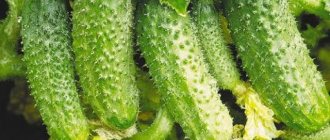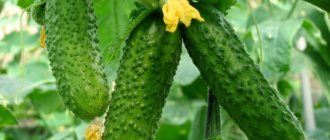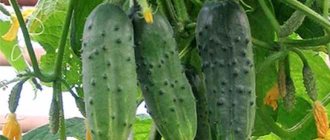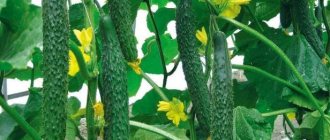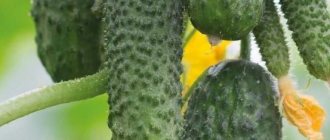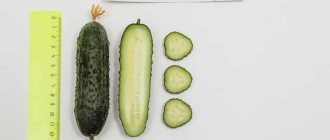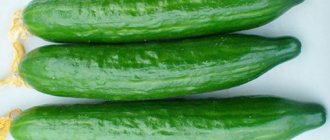Beam splendor cucumbers are a unique hybrid that was bred in the 13th year of this century. It is distinguished by high yield, excellent taste and the ability to grow at low temperatures (the variety was developed specifically for the Northern part of Russia).
Cucumber seeds of the “Puchkovoe splendor” variety
Cucumbers “Beam Splendor”
Due to the fact that the fruits grow in bunches, from one bush you can collect as many cucumbers as 10 bushes of ordinary varieties produce.
Description of cucumbers
The variety can be grown in a greenhouse, as well as in greenhouses, tunnels, containers, and on open ground. Cultivation methods: seedlings and non-seedlings. A high level of productivity is achieved due to the ability to bunch. From one bush you can harvest a harvest equal to 10 plants.
Bunch splendor is an early ripening crop, since the fruits ripen within 30 days after planting. A distinctive feature is that there are flowers of a predominantly female type, so the pollination process is not needed; there are no barren flowers. Up to 7 gherkins ripen in one bunch.
When breeding a hybrid, two varieties were simultaneously crossed, which were endowed with the best quality indicators. Beam splendor is the brainchild of the first generation and belongs to the f1 class. This means that it is completely impossible to obtain seeds at home (seed material must be purchased new every year).
general characteristics
Fruit characteristics:
- shape – cylindrical, smooth;
- the tips of the cucumbers are slightly rounded;
- the surface is covered with minor tubercles;
- maximum length – 11 cm (therefore a gherkin);
- shade – light green;
- there are longitudinal stripes;
- there are small spines and white pubescence;
- apex – narrowed;
- fruit weight – 70-85 grams;
- taste – without bitterness, sweet;
- the pulp is juicy with a compacted structure, due to which there are no voids;
- there is a crunch and elasticity, which is preserved after heat treatment.
What is a bush:
- branching type – second;
- there are few side shoots;
- blooms in a bouquet manner;
- in one bunch there are from 3 to 7 ovaries;
- leaves are small green.
The variety is considered indeterminate, which means the central stem grows tall. Thanks to this, the plant climbs like a vine, independently clinging to the support. Indeterminate species do not need to be pinched.
Productivity
Since Tufted Splendor is a parthenocarpic hybrid, additional pollination is not necessary. Therefore, the variety is considered high-yielding - from 1 sq. m you can collect up to 40 kilograms of greens.
Application
The range of uses for gherkins is quite wide, since the fruits do not lose their crispness after heat treatment. Where is Beam Splendor used:
- for sale and transportation;
- in preparing salads;
- during salting and pickling;
- in canning for the winter.
Bee-pollinated hybrids
Bee-pollinated hybrids are intended for open ground
First of all, they are suitable for growing in open ground, but they also develop in greenhouses. Recently, these varieties are not as popular as before, but many still grow them.
The best varieties of bunched cucumbers for open ground include those that show high yields and disease resistance.
Babies on a branch
Cucumber Babies on branch F1
Babies on a branch
An early ripening hybrid variety, fruiting begins at 43 days. Refers to medium-sized and medium-branched plants with a female type of flowering. Recommended for development in open ground using temporary cover in the form of film.
The fruit is cylindrical, short, weighing up to 100 g, size - 8-11 cm. When ripe, it has an excellent taste, is not bitter and does not contain voids. It is considered universal - suitable for pickles and for preparing fresh salads.
Siberian Express
Cucumber Siberian Express F1
Siberian Express
The variety is an early ripening variety, since fruit formation begins 42 days after germination. The hybrid is grown in open ground and under film. It is a plant with medium climbing habit, and if part of the side shoots is removed, up to 11 fruits are formed in the axils of the main stem.
Cucumbers are of a traditional color with tubercles, up to 12 cm in size, each cucumber weighs up to 120 g. The taste is excellent, without any signs of bitterness. Suitable for pickling and salads. Productivity in greenhouse conditions reaches 15 kg.
King of the bed
Cucumber King of the bed F1
King of the bed
The plant is powerful, has an average degree of branching. Can be grown in open ground with temporary film cover. The taste is without bitterness, suitable for canning and salads.
The fruit is dark green in color with small stripes, up to 11 cm long. Up to 5 fruits are tied in each node. The yield is average - about 6 kg of cucumbers per 1 sq. m. Harvesting is comfortable.
It is better to plant seedlings, but often the seeds are planted directly in open ground. The hybrid is unpretentious and resistant to weather changes.
Hokus
Cucumber Hokus
Hokus
The hybrid has an average ripening period. Produced in Finland, suitable for regions with unstable climates.
It is distinguished by stable yield and gradual ripening of fruits. It can be grown by seedlings and by planting seeds in open ground, especially in warm regions. The size of ripe greens reaches 15 cm.
Minion
Cucumber Darling F1
Minion
Fruiting begins on days 45-47 from the moment the first shoots appear; it can be classified as a mid-early variety. The plant is vigorous with abundant foliage, medium branching. It can develop as a whole garland in open ground and in a greenhouse.
Greens are oval-shaped with small black spines. The pulp is quite juicy. The weight of one cucumber is 80 g, the size is up to 10 cm. They produce from 1 sq. m to 16 kg.
The cucumber is tasty, devoid of bitterness, and suitable for preservation.
Seedling growing method
The method of growing cucumbers using seedlings has received well-deserved attention, as it allows you to get earlier harvests. To put it simply, the ripening period is reduced. This is due to the fact that the seed material was strengthened in favorable conditions.
However, not every variety is recommended to be planted in seedlings due to its weak root system. As for the Bunch Splendor, the roots of the seedling are quite powerful and strong, so there are no difficulties when planting seedlings in open ground. The time for transplanting seedlings is early May.
Seed preparation
The first thing to do is to prepare the seed material in accordance with the requirements. To do this you need to do the following:
- Combine warm water (not hot) with table salt, add the seeds, let stand for 15 minutes. After this time, the hollow seeds float to the surface. They will have to be thrown away.
- Next, disinfection is carried out, which allows you to neutralize pathogenic microorganisms. It follows from this that when seedlings are formed, the plant will not be exposed to disease. For disinfection, a weak solution of manganese (potassium permanganate) is used. Soak in the solution for 20-25 minutes, then remove and rinse with water.
- Wet a piece of gauze, place the seed material on it, and cover with a damp cloth on top. Thus, the seeds will remain in a moist environment all the time, due to which the germination process will begin. 3 days is enough for this.
To speed up pecking, a moistened cloth with grains can be placed in a plastic bag and left in a dark place.
Planting seeds and caring for seedlings
It is most convenient to plant seeds in peat briquettes or pots - there is no need to carefully remove the root system, and peat acts as a natural fertilizer.
If this is not possible, then plant the grains in any convenient container. In this case, it is necessary to fill the container with prepared soil. To do this you will need humus, lime and mineralized fertilizer. All components are combined with the soil and laid out in a planting container. You can also use purchased soil.
Rules for sowing seeds:
- level the ground;
- make grooves 1 to 2 cm deep;
- lay seed material;
- cover with soil;
- pour water at room temperature;
- cover with film or glass;
- put in a warm place.
Watering
After the first shoots appear, the protective film is removed and the container is transferred to the windowsill, where there is a lot of light. The temperature in the room should be 23 degrees. From this moment on, it is necessary to maintain optimal soil moisture - it should not be wet, but always moist. Water temperature is 27-30 degrees.
Watering is carried out in the morning and mainly under the root system. Try to avoid getting moisture on the leaves. It is forbidden to water from a watering can; it is better to use a spray bottle. Diving into open ground is carried out after 2-3 full-fledged leaves appear.
Hardening of seedlings
In order for seedlings to quickly adapt to open ground, it is necessary to carry out the procedure of hardening the plant. This must be done 2-3 weeks before the dive. How to harden:
- take the container with seedlings to the balcony or open the window and leave for 1-2 hours;
- the next day, the hardening time increases by 20-30 minutes;
- then increase the time daily so that the seedlings are outdoors during the daytime.
Transplanting seedlings into the ground
Before planting seedlings, soil preparation is required. To do this, they dig it up and add organic fertilizers (slurry, chicken droppings, etc.). The transplant process is as follows:
- dig holes (depth from 8 to 12 cm);
- moisten the holes with water;
- remove each bush from the container (if in peat pots, then there is no need to remove the plant from them, since planting is carried out together with an organic object);
- place the cucumber root system in the hole;
- sprinkle with earth and compact;
- cover with film (covering is carried out at night, the film must be removed during the day).
Landing rules:
- the distance between bushes should be 30-50 cm, between rows - 40-50 cm;
- diving is carried out after sunset - this makes it easier for the plant to adapt to new conditions;
- per 1 sq. m 2 bushes are planted;
- watering is done daily in the morning or evening;
- When the plant has completely taken root and become stronger, it is enough to water every other day or once every 3 days.
Cucumber care
When the bush grows, it is necessary to form it into one stem. The fact is that Bundle Splendor produces a significant number of ovaries on the central stem. If you use side shoots, the yield level may decrease. What should be done:
- remove shoots (even if there are ovaries) in the lower 4 axils;
- the remaining shoots are removed as they grow.
How to properly care for:
- Bunch splendor prefers high humidity, so you must strictly follow the watering rules. The water should be warm and settled.
- Feeding is required. The first time is 10 days after planting the seedlings in a permanent place. For this, liquid chicken droppings or manure are used. You can also use specialized organic products purchased in the store. For example, Biud fertilizer, which is diluted with warm water in a ratio of 1:20. The next feeding is carried out after 7-8 days. To do this, you need to take a complex fertilizer, for example, Potassium Humate or Effecton.
Seedless growing method
Planting seeds directly into the ground is convenient, quick and economical. Especially when it comes to a variety like Tufted Splendor. Because the plant was bred to grow in cool temperatures. You need to know that, unlike the seedling method, the ripening period of fruits moves forward by 10-15 days.
What rules should you follow:
- The variety is early ripening, but it is not wise to rush to plant seeds in open soil. It is necessary to wait until there is no frost. Therefore, the main dates range from May 20th to June 10th.
- Before planting, the soil is dug up and fertilized. The soil must be disinfected. Copper sulfate is used for this (15 grams of the substance per bucket of water is enough).
- Approximately 10-12 days after planting, it is necessary to thin out the sprouts. To do this, each seedling is assessed for strength (weak shoots are removed with garden shears). The next thinning is carried out after the leaves appear.
- Immediately after sowing, it is necessary to cover the seedlings with film at night. The same is done during the day if it is cloudy and cold. Don't forget to ventilate the plants periodically.
How to choose a place for sowing:
- Tufted splendor takes root under any conditions, but the place must still be sunny and warm (without wind or drafts).
- The soil must be loose and slightly acidic. If there is high acidity, you need to do the following: add dolomite flour, slaked lime, wood ash, chalk or organic matter to the soil. To increase acidity (if it is too low), acid (oxalic, citric) is added. To do this, add 2 tbsp to 10 liters of water. l. substances.
- The depth of groundwater is taken into account. If it passes closer to the surface of the earth, then watering is carried out much less frequently. Otherwise, the risk of rotting of the root system increases.
- Next to the cucumber crop, you can plant sunflowers and corn, lek for greens and radishes. The first two plants can be used as the main support for the trellis.
- Neighborhood with herbs (mint, rhubarb, thyme, coriander) is not allowed.
- It is prohibited to plant the variety after any type of cucumbers, pumpkins, zucchini, melons, and watermelons.
Planting seeds
After preparing the soil, the surface is leveled. Next, holes are created at a distance of 30-50 cm from each other. To save space, you can plant the variety in a checkerboard pattern.
4-5 seeds 2 cm deep are placed in one hole. After this, the crop is watered and covered with film until shoots appear.
Watering
The soil should always be moist. Otherwise, the fruits will be dry and uncrisp. And the yield will decrease many times. Rules:
- You need to water once every 2-3 days, depending on climatic conditions;
- water is added early in the morning or late in the evening;
- per 1 sq. m requires 25-30 liters of water;
- the liquid should be warm;
- if there is drought, then watering is carried out daily, during rains much less often;
- type of irrigation – drip;
- After moistening, loosening or mulching is carried out.
Weeding and loosening
A huge number of diseases and pests are transmitted through weeds. In addition, the grass “sucks” nutrients from the borage. Therefore, weeding must be done constantly. It is necessary to loosen the soil weekly. This promotes the supply of oxygen to the root system.
Stepsoning
For high productivity and fruiting, bunch splendor needs pinching. This variety independently regulates the formation of the bush, so side shoots rarely grow. But this happens due to certain reasons, so it is important to monitor the process of shoot formation. As each new element appears, they are removed. If not only the central trunk but also the shoots bear fruit, the yield is significantly reduced.
Garter
Many cucumber crops are not tied, but for bunched varieties this method is not acceptable. This is due to the fact that their central stem grows strongly and there are no side shoots. Other benefits of the Beam Splendor Garter:
- significant space savings (with the garter-free method it is necessary to plant plants over long distances so that they can be freely located on the surface of the soil);
- light enters evenly, which is correctly distributed over absolutely all brushes and ovaries;
- the culture is well ventilated;
- convenient to form a bush;
- the fruits are collected in their pure form;
- cucumbers do not get wet from moist soil;
- it is easier to loosen and weed;
- leaves and stems are fully treated with agents against diseases and pests;
- the harvesting process is simplified;
- the risk of leaf infection is reduced, since there is no contact with weeds and soil.
Methods for gartering a bush:
- Horizontally. A support is installed near each plant, along which the stem curls.
- Vertical. Wooden supports are placed on the side parts of the bed, which are connected to each other with wire, wooden slats, and threads. The stem is grasped by these binders.
- Grid method. A net is installed near the bed, along which the plant is woven.
Top dressing
Fertilizing plants is extremely necessary, since the lack of nutrients leads to a change in appearance, reduced yield and the risk of disease. This is due to the low level of immunity in the cucumber bush.
It is important to strictly adhere to the dosages indicated in the instructions (when using drugs), since an excess of minerals also entails negative consequences. For example, if the nitrogen concentration is exceeded, then the green mass grows rapidly, but the fruits stop their development. If there is an excess of potassium fertilizer, the plant withers, etc.
What do we have to do:
- Immediately after planting the seedlings or after the formation of seedlings using the non-seedling growing method, it is necessary to treat the seedlings with urea. To do this, you need only 10-12 grams of the substance per 10 liters of water.
- About a couple of weeks after planting, the soil is fertilized. The drug Ammofoska is added to it (5 grams are enough for 1 sq. m). Additionally, a solution is made from superphosphate (60 grams), urea (15 grams) and water (bucket).
- When the bush is flowering, Nitrophoska is used, which is diluted with water in a ratio of 40 grams per bucket. You can use Diammofoska (20-25 grams are needed for 1 square metro).
- When the first fruits are set, potassium nitrate is required. For 10 liters of water 30 grams. It is recommended to apply fertilizer weekly.
- In order for the seedlings to grow actively, liquid manure and chicken droppings are used.
- To strengthen the immunity of plants and the root system, a yeast solution is introduced. It's easy to prepare:
- heat 20 liters of water;
- dissolve 400 grams of fresh yeast in it;
- add 60 grams of granulated sugar;
- mix thoroughly and let ferment for 2-3 hours;
- Dilute the resulting liquid in 100 liters of warm water.
- Wood ash in dry or liquid form is periodically added. In the first case, the substance is scattered under the roots, in the second, it is combined with water (300 grams of ash per 10 liters).
- Herbal cocktails are useful. Dandelion and nettle are used. Cooking method:
- fill one third of any container with grass;
- pour warm water to the top;
- cover tightly with a lid;
- let it brew for 7-10 days;
- combine with water in a ratio of 1:5;
- add culture.
Features of care
Caring for sown cucumbers in general does not depend on the place where they are planted and involves a standard set of actions: watering and fertilizing the plants, loosening and mulching the soil, tying up and forming cucumber bushes.
Frequency of irrigation and fertilization
A sufficient level of moisture is the first thing cucumbers need, so monitoring the regularity of watering will always be an important task for any gardener. If the soil constantly dries out, the cucumbers will be small and inconspicuous, with voids inside the fruit.
Find out in more detail how to properly water cucumbers in a greenhouse and in open ground.
To prevent this from happening, plantings of the described variety are watered at least once every three days, spending about three buckets of water per 1 m² of bed. True, weather conditions also play a significant role in the regularity of the procedure, so in case of severe drought, watering can be carried out daily, and in the rainy season it can be completely eliminated, of course, if we are talking about open soil.
The liquid for irrigation should be moderately warm, especially at the stage of ovary formation. Otherwise, a massive discharge of inflorescences and the spread of root rot, which can destroy the entire bush, are possible.
To water plants in open areas, a watering can or hose can be used, and in greenhouse shelters, a more convenient way to moisturize would be to organize a drip irrigation system
As fertilizers for feeding adult cucumber bushes, it is worth using nitrogenous and complex mineral substances with regular application once every 14 days. The plants are fed for the first time after the ovaries have formed, and the last time nutrients are added to the soil at the end of fruiting of the bushes. From organic substances, in this case, manure solutions prepared from one part of mullein or chicken droppings and 10 or 20 parts of water, respectively, would be appropriate.
Important! A safe natural fertilizer for cucumber plantings is considered to be a nutritious herbal cocktail made from chopped nettles and crushed dandelions, poured into a barrel 1/3 of its volume. Having filled this mixture with water, all that remains is to infuse the liquid for a week for maximum fermentation, and then dilute it with water in a ratio of 1:5 and use it for watering cucumber beds.
Both options will promote root formation and increase the immunity of the crop, although in the latter case it is better to use yeast supplements: 200 g of yeast should be dissolved in 10 liters of warm water, add 30 g of sugar and, after infusing for two hours, additionally diluted in 50 liters of water. An acceptable alternative is an ash solution, for the preparation of which 150 g of ash is dissolved in 5 liters of water and added to the soil at the initial stages of plant formation and during fruit growth.
A sufficient amount of micro- and macroelements in the soil contributes to the formation of new ovaries in those sinuses in which green plants have already appeared and were picked when fully ripe. This ability allows us to classify the Tufted Splendor variety as a premium class variety.
Garter and bush formation
The variety Beam Splendor belongs to vigorously growing crops, so the bushes have to be formed into one stem. This allows you to improve lighting and improve the quality of nutrition of the ovaries, which means you can hope for a more abundant fruit harvest. Formative actions are performed in the following sequence:
- To begin with, in order for the bush to gain strength, the side shoots and all developing ovaries are removed from its first 3-4 axils.
- After another 1–1.5 weeks, you can begin removing the side lashes, leaving only the ovaries themselves and achieving one leaf and one bunch of ovaries in each node.
If, after harvesting the first harvest, you feed the plants with nitrogenous compounds, new fruits will begin to form in the remaining nodes again. For their normal development, the abundance of watering must also increase during this period.
We recommend reading about the best methods for tying cucumbers.
Soil care
Any crop develops better if a sufficient amount of air reaches its root system, so it is worth making every effort to prevent the formation of a dense crust on the surface of the cucumber beds. The problem of soil clogging can be avoided by regularly loosening it, which is done 3-4 hours after the next watering.
However, given the superficial location of the root system of the Beam Splendor cucumbers, you should not dig the tool into the ground more than 8–10 cm, otherwise there is a high probability of damage to the rhizome.
Simultaneously with loosening, you can also remove weeds, which are very easily removed from wet soil. At the end of the procedure, all that remains is to mulch the surface with a five-centimeter layer of sawdust or peat mulch, although this is not necessary and is useful only in cases where you do not have a lot of time for frequent watering and need to retain moisture in the soil for as long as possible
Pests and diseases of cucumbers Beam splendor
With proper care and timely preventive treatment of shrubs and soil, the Tufted Splendor variety is not susceptible to diseases and attacks by insect pests. But sometimes cases of morbidity still occur.
Anthracnose
The main reason is increased soil moisture, so you should not overwater the plant (the soil should be moist, not wet). Manifests itself with the following symptoms:
- the formation of light spots on the leaves;
- fragility of the leaf plate;
- the occurrence of ulcers;
- stem breaking and dying.
For the purposes of prevention and treatment, the following manipulations are performed:
- before planting seeds, soak the material in a manganese solution or the Immunocytophyte preparation;
- disinfect the soil and greenhouse;
- immediately remove affected elements;
- After watering, add Bordeaux mixture (1%) under the root system;
- treat the soil with Abiga Peak (0.5%);
- Spray the trunk and leaves with a solution of Strobi or Quadris.
White rot
The disease occurs due to infection with fungi. This is facilitated by high air and soil humidity (during long rains and cool weather). Symptoms:
- the formation of a whitish coating on the leaves;
- presence of mucus;
- rotting;
- fruit damage.
The following methods are used for prevention and control:
- cut off areas affected by the pathogen;
- Apply lime or ash solution to the cut site;
- disinfect the soil;
- if the bushes are planted too densely, thin them out;
- spray with a solution: 10 liters of water, 2 grams of copper sulfate, 10 grams of urea.
Gray rot
The reason is increased humidity, a sharp change in temperature. Signs:
- the presence of gray spots on the foliage that stick when touched;
- formation of fluff on the stem and fruits;
- stem rotting;
- softening the gherkins.
What to do:
- respect the neighborhood (pumpkin, zucchini and similar crops are excluded);
- disinfect the soil using a solution of manganese or copper sulfate;
- in case of frequent rains, cover the plantings with film;
- use an iodine solution (1 part substance, 2 parts water) - treat the soil and plants every 3-4 days;
- for prevention, spray plants with Trichodermin once every 20 days (100 grams per bucket of water).
Aphid
This insect spreads rapidly throughout the garden, so immediate measures are necessary. Aphids can be recognized by the following manifestations:
- leaf curling;
- falling of flowers;
- formation of a sticky coating.
What to do to get rid of aphids and prevent their attack:
- Before planting seeds or seedlings, disinfect the soil;
- Before fruit formation, treat the surface of the leaves with one of the preparations: Fitoverm (5 ml of solution per 1 liter of water), Aktara (1 gram of substance per 10 liters of water), Iskra (1 tablet per bucket of water);
- periodically spray with a solution of wood ash (2 kg per 10 liters of water);
- spray the plant with soap solution;
- during fruiting, treat with herbal cocktails from tomato tops, nettles, dandelion, and chamomile.
Whitefly
The insect infects the plant during hot sunny days and spreads rapidly. How to determine whitefly damage:
- a sticky coating forms on the inside of the foliage;
- leaves wither and fall off;
- growth and fruiting slows down;
- larvae become visible.
Preventive measures and therapy:
- use the drug Bud for spraying seedlings and seedlings using the seedless method of growing (10 grams per bucket of water);
- carry out timely loosening of the soil;
- every 10 days, spray the plant with an herbal cocktail (for 1 liter of boiling water you will need 60 grams of root and leaf parts of common dandelion);
- use the following medications: Actellik (1 gram per bucket of water), Confidor (2.6 ml per 10 liters of water), Iskra (1 tablet per bucket of liquid).
Spider mite
Spider mites appear in dry weather, so in such cases it is necessary to especially carefully monitor soil moisture. Manifested by the following symptoms:
- the location of the insect is the inside of the leaves;
- wilting of the bush;
- drying out of the plant.
How to get rid of the pest and prevent its appearance:
- remove weeds that carry insects;
- moisten the soil;
- loosen the soil;
- remove damaged leaves and destroy by burning;
- treat with preparations: Fitoverm (1 ml of product per 1 liter of water), Actellik or Aktara (1 gram per bucket of water).
Possible difficulties and problems
Beam splendor is a fairly stable and unpretentious variety, but some gardeners periodically encounter certain difficulties. What problems exist, their causes and what to do are given in the table:
| Features of the problem | Causes | What to do? |
| Excessive stretching of the fetus. Discoloration of the leaf part. Late flowering. A small number of ovaries on the bush. Bad taste. | The main reason for these troubles is lack of lighting. | If the bushes are not tied up, be sure to do so, which will ensure the penetration of sunlight. Plant the variety in a sunny location. |
| Poor plant development. Presence of bitterness in taste. Yellowing of leaves. | This happens when water often gets on the leaves during watering. | Water the plant using the drip method mainly under the root system. |
| Lack of ovaries. Falling of the ovaries. Dry leaves. | Reduced plant immunity due to lack of nutrients. | Feed cucumbers with fertilizers in a timely manner. |
| Stem rotting. | Excessive watering. | Adjust the soil moisture regime. |
| Dry leaves. Yellowness of the plant. | There are several reasons: lack of moisture, root damage, hypothermia. | Increase the amount of water. Pour the Insecticide solution under the root. Cover the plantings with film. |
Bush formation
Cucumber vines of this variety actively grow upwards and to the sides. Therefore, experts recommend that the bush be formed. You only need to leave one stem. Then the bush will stretch upward, and not to the sides. All leaves will receive sufficient sunlight, which helps increase yield.
Getting the job done is quite easy. It is necessary to remove the side shoots in the leaf axils approximately once a week, and also carefully cut off the lashes from the main stem, not allowing the bush to grow in different directions.
You will have to spend some time on this work. But the high yield will please the diligent gardener.
How to harvest and store crops?
Bunch splendor differs from many varieties in that the fruits can be harvested daily over a long period of time. In addition, it is extremely necessary to do this - if you do not collect ripe cucumbers, then new ovaries will not appear, and unripe elements will slow down their growth. Collection is carried out in the morning or late evening.
It is advisable to store the variety in a cool place for 5 days. To increase shelf life, follow these rules:
- Do not wash the fruits before placing them;
- check the cucumbers for dryness (there should be no moisture);
- cut the fruits with garden shears along with the stem;
- inspect for damage;
- do not allow the size to exceed 11 cm (this will be overgrown and will not store well).
Advantages and disadvantages
Advantages of the Beam Splendor variety:
- self-pollinating;
- the highest level of productivity;
- early ripening (the first harvest can be harvested in June-July);
- long-term fruiting (more than 3 months);
- possibility of growing in seedlings and without seedlings;
- excellent taste and appearance;
- transportability;
- preservation of crunch after heat treatment;
- fruit elasticity;
- purpose – bad climatic conditions;
- resistance to diseases and high air humidity (with frequent fogs);
- versatility of use.
Minuses:
- high cost of seed material;
- the need to buy new seeds every year.
Reviews
★★★★★
Vera, 43 years old. I first tried to plant bunched splendor 3 years ago.
First I grew seedlings, then replanted them, and last year I decided to go straight into the ground. The result was impressive - indeed, the yield is the same as with the seedling method of cultivation, the fruits are elastic, the bushes are strong. These cucumbers are used for canning; I lightly salt them. And how delicious the salads are! But I’m especially pleased with the amount of harvest. Now there is only this variety of cucumber in my beds. ★★★★★
Victor, 37 years old. I have been growing Tufted Splendor for a long time.
I always use peat pots for planting seeds - it’s more convenient to transplant seedlings. But I take quite a few of them, since the root system is quite powerful. I tried planting without seedlings. Yes, the result is not bad, but I start picking cucumbers a couple of weeks later. I make sure to disinfect the seeds in potassium permanganate and add copper sulfate to the soil. During growth after transplanting to a permanent place, I also fertilize it. I use minerals and organics. Maybe that’s why my plants never get sick. The taste of the fruit is quite sweet, the pulp is juicy, and the seeds are small. For preservation I pick gherkins (usually 8-9 cm in size), the cucumbers turn out crispy. Hide
Add your review
Beam splendor cucumbers are distinguished by very high productivity, ease of care and planting. They can withstand low temperatures, bear fruit for a long time and delight with excellent taste. Excellent for sale as they are not damaged during transportation. The main thing is to always tie up the bushes and strictly follow all the recommendations of specialists.
0
0
Copy link
History of the variety's creation
The hybrid Beam Splendor was bred by Ural breeders.
When developing a new variety, experts sought to create a plant that would have high productivity, resistance to low temperatures and diseases, and unpretentiousness. And all these qualities were combined in the hybrid “Beam Splendor”. The variety was bred at the beginning of this century and was introduced to vegetable growers in 2013.
The Tufted Splendor cucumber is recommended for cultivation in most Russian regions, and it can grow in open ground even in the northern regions.
frame class=”lazy lazy-hidden
